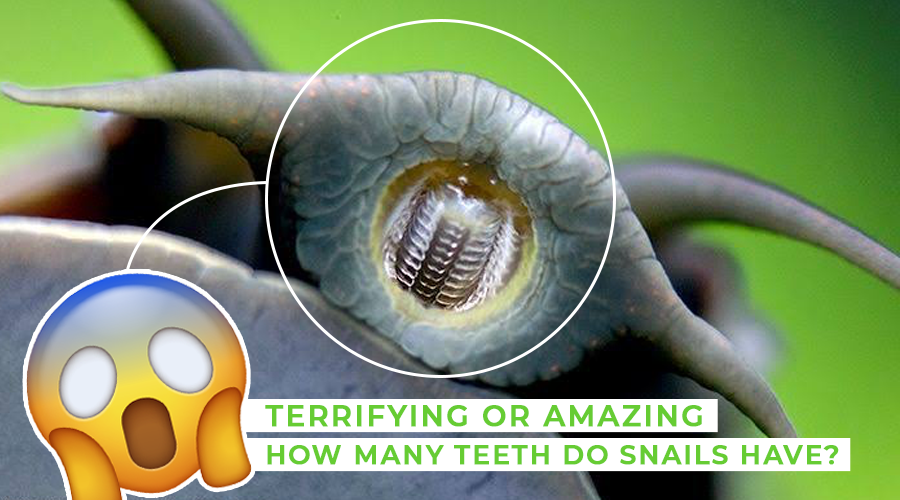Do snails have teeth? You might be surprised by the answer! Your dentist in Clairemont is diving into this curious topic today to explore the world of snail anatomy. From land to sea, these tiny creatures have some jaw-dropping secrets—literally. Keep reading to uncover the truth about snail teeth and more!
Snails come in many varieties, broadly categorized into aquatic (sea and freshwater) and terrestrial (land-dwelling). Each type has unique adaptations, but they all share one intriguing feature: a feeding mechanism that’s both terrifying and amazing. Let’s break it down.
What You Need to Know About Land Snails
Land snails are the ones you might spot in your garden after a rainy day. They glide around using a slippery mucus or slime, which helps them climb rough or inclined surfaces with ease. Their iconic shell, made of calcium carbonate, acts like a portable shield, protecting their soft bodies and vital organs—like their lung—from predators.
Here are some quick facts about land snails:
- Breathing: Unlike their aquatic cousins, land snails breathe atmospheric oxygen through a lung.
- Tentacles: They have two pairs of retractable tentacles—one with eyes, the other for sensing their surroundings.
- Reproduction: These snails are hermaphrodites, meaning they have both male and female reproductive organs, but they still need a partner to reproduce.
Their lifespan varies by species, typically ranging from 2 to 7 years, though some have been known to live up to 30 years! Predators like birds, snakes, and even other mollusks often cut their lives short, but their shell offers decent protection.
What You Need to Know About Freshwater Snails
Freshwater snails thrive in puddles, lakes, and rivers, with around 4,000 species worldwide. Like land snails, they’re hermaphrodites—but here’s the twist: they can self-fertilize their eggs, making their reproductive abilities truly impressive.
Their life expectancy is shorter, usually up to 1 year, though some hardy specimens reach 5 years. They’re less common than land snails but play a vital role in aquatic ecosystems by feeding on algae and debris.
What You Need to Know About Sea Snails
Sea snails, found in saltwater environments, are known for their stunning spiral shells. These shells, often large and colorful, have an opening that lets their soft, white bodies move in and out. Fun fact: ancient cultures used these shells as wind instruments, similar to trumpets, thanks to their unique shape.
Sea snails share traits with other gastropod mollusks (a group that includes octopuses and slugs), but their shell designs and diets set them apart. Speaking of diets…
What Do Snails Eat? A Look at Their Diets
Snails might be small, but their eating habits are diverse and fascinating. Here’s how their diets differ by type:
Land Snails
- Diet: Mostly herbivorous, munching on plant debris, fruits, and even bits of earth or stone for calcium to strengthen their shells.
- Carnivorous Exceptions: Some species turn predatory, feasting on smaller snails or insects.
- How They Find Food: With poor vision, they rely heavily on their keen sense of smell.
Freshwater Snails
- Natural Diet: Algae, aquatic plants, plankton, and organic remains scraped from stones.
- Pet Diet: If you keep one as a pet, fish flakes or scales in their aquarium work well.
Sea Snails
- Varied Diets: Some are herbivorous (eating algae), while others are omnivorous or carnivorous, targeting plankton, clams, sponges, or seabed waste.
- Feeding Style: They scrape or scoop food from rocks and underwater surfaces.
So, Do Snails Have Teeth?
At first glance, snails don’t seem like they’d have teeth. Their delicate, slimy bodies hardly suggest a toothy grin. Yet, here’s the big reveal: snails don’t have traditional teeth, but they do have an organ called the radula—a jaw-like structure packed with tiny, tooth-like projections.
What Is a Snail’s Radula?
The radula is a ribbon-like organ lined with rows of chitin teeth—not as hard as human teeth, but tough enough to grind food. Think of it as nature’s version of a dental multitool! Each row features a central tooth flanked by lateral ones, forming a microscopic chewing machine.
How Many Teeth Do Snails Have?
The number of teeth varies by species, but estimates suggest most snails boast up to 25,000 teeth on their radula. That’s right—thousands of tiny teeth working together! For comparison:
- Humans: 32 teeth.
- Sharks: Hundreds over a lifetime.
- Snails: Thousands at once!
How Do Snails Use Their Teeth?
The eating process is surprisingly human-like:
- They grab food with their mouth.
- The radula scrapes or crushes it into digestible bits.
- The food moves on for digestion.
Because their diet (like rocks or tough plants) wears down these teeth, many snails regrow them continuously, ensuring they’re always ready to munch.
Why Snails’ Teeth Are a Survival Superpower
Snails might seem fragile, but their radula and shell make them survivors. They thrive in diverse habitats—gardens, parks, streets, oceans, and rivers—thanks to their unique anatomy. With over 60,000 species worldwide, their diversity is staggering. Some, like the venomous cone snails, even use their radula teeth to hunt prey with toxic precision!
Next time you spot a snail, remember: beneath that unassuming exterior lies a creature with thousands of teeth, perfectly adapted to its world.
Want More Fascinating Facts?
Did this peek into snail anatomy leave you curious? Subscribe to our blog for more quirky nature insights. Have a snail-related question? Drop it in the comments below—we’d love to hear from you!



